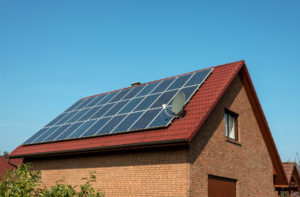As a homeowner with a solar panel system, it’s important to understand the variations in solar panel output between winter and summer. This article will explore the factors influencing solar panel performance during these seasons and how you can optimize your system’s energy production year-round.
Contents
- 1 Key Takeaways
- 2 How Solar Panels Work
- 3 Factors Affecting Solar Panel Output
- 4 Solar Panel Performance in Winter
- 5 Solar Panel Performance in Summer
- 6 Optimizing Solar Panel Performance Year-round
- 7 Expert Insights from Our Solar Panel Installers on Seasonal Solar Panel Output
- 8 Case Study: Optimizing Solar Panel Output in a Seasonal Climate
- 9 Experience Solar Excellence with Us!
- 10 Conclusion
Key Takeaways
- Solar panel output is influenced by sunlight intensity, temperature, daylight duration, and cloud cover.
- Winter months generally result in lower solar panel output due to reduced sunlight intensity, shorter days, and potential cloud cover.
- Summer months offer increased sunlight intensity, longer days, and higher energy production potential, making it an optimal time for solar panel performance.
How Solar Panels Work
Solar panels harness sunlight’s power to generate electricity through the photovoltaic effect. This process involves several key steps:
- Photovoltaic Cells: Solar panels comprise multiple photovoltaic cells, usually composed of silicon. These cells have two layers of semiconductor material, with one layer containing an excess of electrons and the other with a deficiency of electrons.
- Sunlight Absorption: When sunlight hits the solar panel, the photons from the sunlight’s rays interact with the photovoltaic cells. This interaction causes electrons in the semiconductor material to become energized and break free from their atomic bonds, creating a flow of electrons.
- Electrical Current Generation: As the energized electrons move through the photovoltaic cells, they create a flow of electrical current. This current is in the form of direct current (DC), which is then converted into alternating current (AC) by an inverter to power the electrical devices in your home.
- Net Metering and Grid Interaction: If your solar panel system generates more electricity than your home needs, the excess power can be returned to the grid. This is often facilitated through net metering programs, where you receive credits for the excess energy supplied to the grid, reducing overall energy costs.
Understanding the inner workings of solar panels helps us appreciate how sunlight is transformed into usable electricity, providing a clean and renewable power source for our homes.
Factors Affecting Solar Panel Output
Several factors influence the output of solar panels, ultimately impacting the amount of electricity they generate. These factors include:
Sunlight Intensity and Angle of Incidence
The intensity and angle at which sunlight reaches the solar panels directly affect their output. During the winter months, the sun’s rays are less intense, and the angle of incidence is lower. This reduces energy production compared to the summer when the sun is more directly overhead.
Daylight Duration and Seasonal Variations
The number of daylight hours varies throughout the year due to seasonal changes. Winter months have shorter daylight hours, limiting the time for solar panels to capture sunlight. In contrast, summer months have longer daylight hours, allowing more solar energy to be absorbed and converted into electricity.
Temperature and Panel Efficiency
Solar panels function more efficiently at lower temperatures. While winter months may bring colder temperatures, they can also lead to increased panel efficiency. On the other hand, high temperatures during summer can reduce panel efficiency, resulting in slightly lower energy production.
Incidence of Cloud Cover
Cloudy days can significantly impact solar panel output. When clouds block the sun’s rays, less sunlight reaches the solar panels, reducing energy production. However, even on cloudy days, solar panels can still generate electricity, albeit at a lower rate.
Understanding these factors helps homeowners anticipate and manage the variations in solar panel output throughout the year.

Solar Panel Performance in Winter
During the winter months, solar panel output tends to be lower compared to other seasons due to several reasons:
- Reduced Sunlight Intensity: Winter months experience lower sunlight intensity, primarily due to the angle at which the sun’s rays reach the Earth—the reduced intensity results in decreased energy production by solar panels.
- Shorter Days: Winter days have fewer daylight hours, limiting the time for solar panels to generate electricity. With less daylight, there is a shorter window of opportunity for the panels to capture and convert sunlight into usable energy.
- Potential Impact of Cloud Cover: Winter often brings cloudier conditions, which can further reduce solar panel output. Cloud cover obstructs the direct sunlight required for optimal energy production, decreasing energy generation.
However, it’s important to note that even during winter, solar panels can still contribute to your energy needs. They continue to produce electricity, albeit at a lower rate, and can still significantly reduce your overall energy consumption.
Solar Panel Performance in Summer
In contrast to winter, solar panel performance during the summer months tends to be more favorable:
- Increased Sunlight Intensity: Summer months bring higher sunlight intensity as the sun’s rays strike the Earth more directly. This increased intensity allows solar panels to generate more electricity, producing higher energy.
- Longer Days: Summer days have longer daylight hours, providing solar panels a longer duration to capture sunlight and convert it into usable energy. Extended exposure to sunlight results in greater energy production.
- Potential Heat-Related Efficiency Losses: While high temperatures in summer can slightly reduce solar panel efficiency, the overall impact is typically minimal. Modern solar panels are designed to withstand and operate efficiently in high-temperature conditions.
During summer, solar panels have the potential to generate ample electricity, helping to meet your energy needs and potentially even feed excess energy back into the grid.
Optimizing Solar Panel Performance Year-round
To optimize solar panel performance and ensure consistent energy production throughout the year, consider the following strategies:
- Regular Maintenance: Keep your solar panels clean and debris-free to maximize sunlight absorption. Regular inspections and cleaning can help ensure optimal performance.
- System Sizing: Ensure your solar panel system is appropriately sized to meet your energy requirements throughout the year. Factors such as your location, energy consumption patterns, and seasonal variations should be considered when determining your system’s size.
- Monitoring and Adjusting Energy Consumption: Utilize energy monitoring tools to track your system’s performance. By monitoring your energy production, you can adjust your consumption patterns and utilize energy-intensive tasks during peak solar production hours.
- Battery Storage: Consider incorporating battery storage into your solar system. Energy storage allows you to store excess energy generated during periods of high solar production for use during periods of lower production or peak demand times. This can help you maximize self-consumption and reduce reliance on the grid.
By implementing these strategies, you can ensure optimal solar panel performance year-round, maximizing your energy production and reaping the benefits of clean and renewable solar power.
Expert Insights from Our Solar Panel Installers on Seasonal Solar Panel Output
Understanding the seasonal variations in solar panel output is crucial for homeowners to manage their expectations and optimize their solar systems effectively. By recognizing these changes, you can plan your energy consumption and maximize your system’s efficiency.
Solar Energy Engineer
Solar panels are designed to perform under various conditions, but the angle of incidence and daylight duration significantly influence their output. Homeowners should be aware of these factors to make informed decisions about their energy usage.
Renewable Energy Scientist
Seasonal maintenance, such as cleaning panels and ensuring they are free from obstructions, is vital for maintaining optimal performance. Even in winter, solar panels can contribute significantly to energy needs if they are well-maintained.
Solar Installation Specialist
Case Study: Optimizing Solar Panel Output in a Seasonal Climate
Background
A homeowner in Denver, Colorado, installed a solar panel system to reduce energy costs and contribute to a sustainable future. Given Denver’s varied climate, the homeowner wanted to understand how to optimize their system’s performance year-round, especially considering the differences in solar panel output between winter and summer.
Project Overview
The project involved several key steps to optimize solar panel performance across different seasons:
Step 1: Site Assessment and System Design
Solar Panels Network USA conducted a thorough site assessment to determine the best placement and angle for the solar panels. Considering Denver’s seasonal climate, the panels were installed with an optimal tilt to maximize sunlight absorption during winter and summer.
Step 2: Installation and Monitoring
The installation team ensured that the solar panels were securely mounted and positioned for maximum exposure. A monitoring system was set up to track energy production and provide real-time data on the system’s performance.
Step 3: Seasonal Maintenance Plan
A maintenance plan was established to ensure the solar panels remained clean and unobstructed throughout the year. Regular cleaning schedules were set up, particularly before winter and summer, to maximize efficiency.
Step 4: Energy Storage and Usage Adjustment
The homeowner invested in a battery storage system to store excess energy generated during peak production times. Additionally, they adjusted their energy usage patterns, performing energy-intensive tasks during periods of high solar output.
Results
The optimized solar panel system led to several notable outcomes:
- Increased Energy Production: By optimizing the tilt and placement of the panels, the system generated more electricity throughout the year, even during the shorter, cloudier days of winter.
- Cost Savings: The battery storage system allowed the homeowner to store excess energy generated during the summer, reducing reliance on the grid during the winter and leading to significant cost savings on electricity bills.
- Enhanced Performance Monitoring: The real-time monitoring system provided valuable insights into energy production and usage, enabling the homeowner to make informed decisions about energy consumption and maintenance needs.
- Sustainable Energy Use: The homeowner successfully reduced their carbon footprint by maximizing their solar system’s efficiency, contributing to a more sustainable future.
Summary
This case study demonstrates the importance of understanding seasonal variations in solar panel output and implementing strategies to optimize performance year-round. By considering factors such as sunlight intensity, daylight duration, and temperature, homeowners can maximize their solar investment and enjoy the benefits of renewable energy in all seasons.
Experience Solar Excellence with Us!
Trust in Solar Panels Network USA, where our seasoned experts deliver top-quality solar solutions for homes and businesses nationwide. With a legacy of countless successful installations and a commitment to sustainable energy, we’re your reliable partner in the solar journey. Ready for a brighter, eco-friendly future? Call us now at (855) 427-0058 and harness the power of the sun!
Conclusion
Understanding the difference in solar panel output between winter and summer is essential for homeowners with solar systems. By being aware of the factors influencing energy production during each season, you can make informed decisions to optimize your system’s performance year-round. Consider adjusting your energy consumption patterns, maintaining your solar panels, and exploring energy storage options to maximize your solar investment. Embrace solar power and enjoy the benefits of renewable energy, regardless of the season.
About the Author
Solar Panels Network USA stands at the forefront of solar energy solutions, driven by a team of seasoned solar engineers and energy consultants. With over decades of experience in delivering high-quality solar installations and maintenance, we are committed to promoting sustainable energy through customer-centric, tailored solutions. Our articles reflect this commitment, crafted collaboratively by experts to provide accurate, up-to-date insights into solar technology, ensuring our readers are well-informed and empowered in their solar energy decisions.

